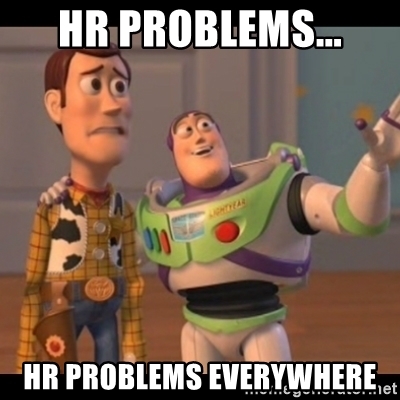5 Diversity & Inclusion myths, debunked!
What are the most common Diversity & Inclusion myths? Let's debunk them!
We already answered some of the most common FAQs that prevented decision-makers and company leaders from committing to diversity efforts in the workplace. But how about the most common myths that create an absolutely wrong idea around the concept of diverse and inclusive workplace?
Let’s go through the most frequent ones and debunk them!
Myth #1 - Diversity & Inclusion efforts are responsibility of the HR department alone
Diversity & Inclusion goes beyond hiring and promoting people. Therefore, it is (or should be) a leadership responsibility, shared throughout the organization‘s structure. Of course, Human Resources and Talent Acquisition should have an outstanding comprehension of the matter (crucial in hiring and retainment!), but D&I is a business function that must be shared on all levels in the business.
By analyzing the 3 successful D&I frameworks of companies such as KONE, PwC Finland, and Futurice, we’ve indeed seen how the topics of Diversity, Equity, and Inclusion are shared and embraced by all business functions within the company across all levels. In most cases, the commitment on the subject doesn’t even stop there but involves further stakeholders, partners, and suppliers.
As McKinsey pointed out in its “Delivering through Diversity” report (2017) “CEOs and leaders must articulate a compelling vision, embedded with real accountability for delivery, and cascade down through middle management”. We cannot expect change to come and happen only in one specific and delimited function within the company, but it must interest the organization as a whole on all levels. Everyone needs to share the same vision and understand why it is important to promote Diversity & Inclusion in the workplace, and it is the leadership’s responsibility to set the example.

Myth #2 - Diversity is only about gender and race.
The concept of Diversity is much broader than that. Of course, gender and ethnicity are the most visible and obvious elements and, as such, they represent only the tip of the iceberg. The full spectrum of Diversity encompasses an extremely broad variety of demographics and dimensions: age, disability, gender identity, nationality, sexual orientation, cultural background, religion, political affiliation, mental health, marital situation, thinking style, and more.
It is therefore crucial to have an intersectional approach when thinking of diversity. Starting by acknowledging the full spectrum of elements that characterize a person (and thus a team) is a key factor in creating and fostering and inclusive environment. In fact, ticking one box (gender, race, or both) and ignoring the rest does not automatically make a company diverse or inclusive… It is surely a step towards change, but a lot of work must still be done to be considered diverse and inclusive!
Myth #3 - The terms Diversity & Inclusion have the same meaning: if my company is already diverse, we don’t really need to talk about inclusion.
This is a quite common misconception! Let’s start by saying that having diversity is important – and organizations that are actively implementing measures to ensure this should be celebrated. However, diversity alone is not enough. Having a diverse team that doesn’t feel the sense of belonging and inclusion won’t help you, and it will most likely damage your innovation and productivity levels.

As shown in the graphic above, having diversity in your team does not necessarily guarantee that you’re actually benefiting from it. If the team is not well managed, the productivity level will decrease. However, diverse teams that are well managed will significantly outperform homogenous teams, and guess who’ll benefit from it? Your business, of course! By improving your inclusion strategy, your employees will feel valued, your productivity level will be boosted, and your brand will become a magnet for more diverse and international talent!
Myth #4 - A diverse team will make the decision-making process more difficult and less straightforward.
This Diversity myth has been proven to be patently untrue and the assumption that a more diverse team would negatively affect business results is proof of an unconscious bias that is erroneously informing your decisions. As a matter of fact, over the past decade, countless researches, reports, and indexes have been published with the main goal of demonstrating through concrete case studies, numbers, and projections how businesses all around the world have benefited from having embedded Diversity & Inclusion (D&I) into their company culture.
McKinsey has shown that companies with more culturally and ethnically diverse executive teams were 33 % more likely to see better-than-average profits (2017) and companies with below-average cultural diversity are performing 19 % less in terms of innovation than their competitors with well-managed above-average culturally diverse teams (BCG Diversity & Innovation Survey, 2017).
Therefore, it is safe to say that working on your company culture is vital in order to become attractive to international talent and to perform better than your competitors, taking advantage of this growth opportunity.
Myth #5 - Diversity, Equity, and Inclusion are only buzzwords and companies use them to “check the box”.
Well, this is true only if the company doesn’t seriously commit to embedding Diversity & Inclusion into their strategy and use the D&I programs with the only goal to woke-wash.
Diversity, Equity, and Inclusion are not buzzwords: they are (or should be) a crucial part of your business model, company culture, and brand. It is no longer a “nice-to-have”, as it rather represents a necessity for your business if you want to stay competitive in this fast-changing world. Besides benefiting internally in terms of innovation and productivity, a company that actively advocates the values of Diversity, Equity, and Inclusion will definitely be more appealing externally, too. For investors, customers, and future talents.
As this article from the Washington Post points out, “over the past decade, highly educated young professionals have increasingly prioritized personal values in deciding where to work, whether it’s a commitment to sustainability, philanthropy or social impact”. By 2025, millennials will represent a whopping 75% of the global workforce and they will choose and support companies that reflect their values, contributing to a massive cultural systemic change. Do you still think that Diversity, Equity, & Inclusion are only buzzwords and not the future of any workplace?
Key takeaways:

About the author:

Aurora Grion is the Inclusive Marketing & Communications Specialist at BusinessWiz and a Diversity, Inclusion, and Cultural Studies enthusiast. She has been living and working in 4 different countries in the last 5 years and has therefore a very concrete take on Diversity & Inclusion (D&I) in workplaces, especially when it comes to inclusion of international talent.
Aurora holds a MA cum laude in Cultural Management and is the Vice-President of +Collective, an organization which promotes equality and inclusion in Finland through events and media production.
